人教版七年级英语下册一般现在时态、现在进行时态、一般过去时态三种时态 综合讲解公开课共20页文档
- 格式:ppt
- 大小:2.77 MB
- 文档页数:37
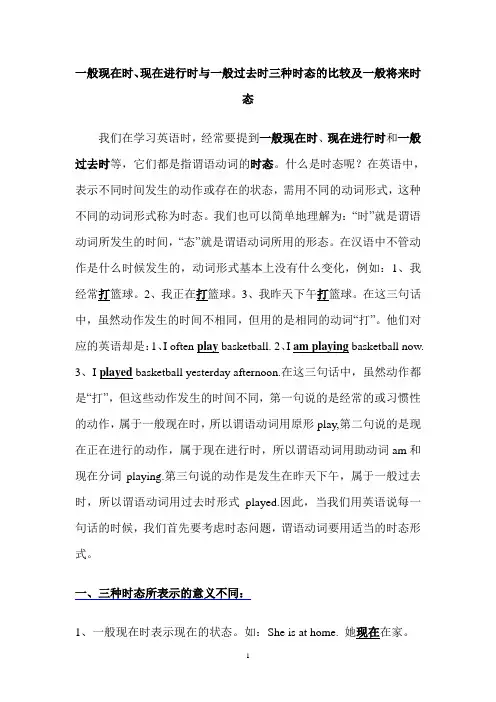
一般现在时、现在进行时与一般过去时三种时态的比较及一般将来时态我们在学习英语时,经常要提到一般现在时、现在进行时和一般过去时等,它们都是指谓语动词的时态。
什么是时态呢?在英语中,表示不同时间发生的动作或存在的状态,需用不同的动词形式,这种不同的动词形式称为时态。
我们也可以简单地理解为:“时”就是谓语动词所发生的时间,“态”就是谓语动词所用的形态。
在汉语中不管动作是什么时候发生的,动词形式基本上没有什么变化,例如:1、我经常打篮球。
2、我正在打篮球。
3、我昨天下午打篮球。
在这三句话中,虽然动作发生的时间不相同,但用的是相同的动词“打”。
他们对应的英语却是:1、I often play basketball. 2、I am playing basketball now.3、I played basketball yesterday afternoon.在这三句话中,虽然动作都是“打”,但这些动作发生的时间不同,第一句说的是经常的或习惯性的动作,属于一般现在时,所以谓语动词用原形play,第二句说的是现在正在进行的动作,属于现在进行时,所以谓语动词用助动词am和现在分词playing.第三句说的动作是发生在昨天下午,属于一般过去时,所以谓语动词用过去时形式played.因此,当我们用英语说每一句话的时候,我们首先要考虑时态问题,谓语动词要用适当的时态形式。
一、三种时态所表示的意义不同:1、一般现在时表示现在的状态。
如:She is at home. 她现在在家。
一般现在时也表示经常的或习惯性的动作。
如:He often plays basketball.他时常打篮球。
2、现在进行时表示现在进行时表示现在(说话瞬间)正在进行或发生的动作。
如:He is playing basketball now.他正在打篮球。
3、一般过去时表示表示过去某个时间存在的状态。
如:She was at home yesterday.她昨天在家。


一般现在时用法:1.现在的动作或状态。
2.习惯性、经常性的动作。
常跟时间状语now、always、usually```3.客观真理。
结构:1.be动词(表主语的状态)主语+be动词(am/is/are)+其他。
2.行为动词(表主语的动作)主语+行为动词(do/does)+其他。
动词单三形的变化规则1.一般情况下,直接加-s,如:cook-cooks2.以s. x. sh. ch. o结尾,加-es,如:guess-guesses, wash-washes, watch-watches, 3.以“辅音字母+y”结尾,变y为i, 再加-es,如:study-studies常用的句式a.含有be动词的:肯定句:主语+be(am/is/are)+其它。
否定句:主语+ be(am/is/are) + not +其它。
一般疑问句:Be(am/is/are) +主语+其它。
(be动词移到句首)用yes/no 回答特殊疑问句:疑问词+一般疑问句。
b.含有实意动词的:肯定句:主语+动词原形/动词单三形(+其它)。
否定句:主语+ don't( doesn't ) +动词原形(+其它)。
当主语为第三人称单数时,要用doesn't构成否定句。
一般疑问句:Do( Does ) +主语+动词原形+其它。
(句首加助动词do, does)当主语为第三人称单数时,要用does构成一般疑问句。
特殊疑问句:疑问词+一般疑问句。
巩固练习用括号内动词的适当形式填空。
1. He often ________(have) dinner at home.2. David and Tom _______(be) in Class One.3. We _______(not watch) TV on Monday.4. Mike _______(not go) to the zoo on Sunday.5. ______ they ________(like) the World Cup?6. What _______they often _______(do) on Saturdays?7. _______ your parents _______(read) newspapers every day?8. The girl _______(teach) us English on Sundays.9. She and I ________(take) a walk together every evening.10. There ________(be) some water in the bottle.11. Mike _______(like) cooking.12. They _______(have) the same hobby.13. My aunt _______(look) after her baby carefully.14. You always _______(do) your homework well.15. I _______(be) ill. I'm staying in bed.16. She _______(go) to school from Monday to Friday.17. Liu Tao _______(do) not like PE.18. The child often _______(watch) TV in the evening.19. Su Hai and Su Yang _______(have) eight lessons this term.20. -What day _______(be) it today?-It’s Saturday.按照要求改写句子1. David watches TV every evening.(改为否定句)___________________________________________________2. I do my homework every day.(改为一般疑问句,作否定回答)____________________________________________________________________________________3. She likes milk.(改为一般疑问句,作肯定回答)___________________________________________________________________________________4. Helen likes playing computer games.(改为一般疑问句,作否定回答) ____________________________________________________________________________________________5. We go to school every morning.(改为否定句)_______________________________________________________6. He speaks English very well.(改为否定句)___________________________________________________7. I like taking photos in the park.(对划线部分提问)________________________________________________________ 8. Jim comes from Canada.(对划线部分提问)___________________________________________________9. She is always a good student.(改为一般疑问句,作否定回答)________________________________________________________________________________________10. Tom and David like going skating.(改为否定句)___________________________________________________现在进行时用法:(句中一般含有now, look, 现在正在进行或发生的动作,也可表示当前一段时间内的活动或现阶段正在进行的动作。


初中英语学习材料madeofjingetieji英语时态详解一、一般过去时:1.概念:过去某个时间里发生的动作或状态;过去习惯性、经常性的动作、行为。
2.时间状语:ago, yesterday, the day before yesterday, last week(year, night, month…), in 1989, just now, at the age of 5, one day, long long ago, once upona time, etc.3.基本结构:be动词;行为动词4.否定形式:was/were+not;在行为动词前加didn't,同时还原行为动词。
5.一般疑问句:was或were放于句首;用助动词do的过去式did 提问,同时还原行为动词。
6.例句:She often came to help us in those days.I didn't know you were so busy.一般过去时一.用“am , is , was”填空1. I _____ a teacher now. I _____ a student five years ago.2. Where ______ it now?3. Where ______ it last Sunday?4. Yang Ling ______ at home now. But she ______ at school yesterday.二.用所给动词的适当形式填空1.Tom _______ (visit) a farm last week.2. The twins _______ (water) the flowers in the garden yesterday morning.3. I _______ (watch) a film with my friend last Friday.4. My father _______ (be) in London last year.5. What_______ (do) you do three days ago?6. _______ (be) there any parks here in 1950?7. What_________(do) you do just now? I __________ (wash) my clothes.三.用所给词的适当形式填空1. It ______ (be) there just now, but it isn’t there now.2. Where’s the camera? It ________ (is) there a moment ago.3. It _______ (be) Helen’s birthday yesterday.4. Tom _______(go ) to visit a farm last week.5. I _______ (watch) a film with my friend last Friday.6. My father _______ (be) in London last year.7. What_______ (do) you do three days ago?8. Where ______ (be) you just now?I _______ (be) in the classroom.9. What ______ you _______(do) last Friday?We ________(water) trees on the farm.二、现在进行时:1.概念:表示现阶段或说话时正在进行的动作及行为。
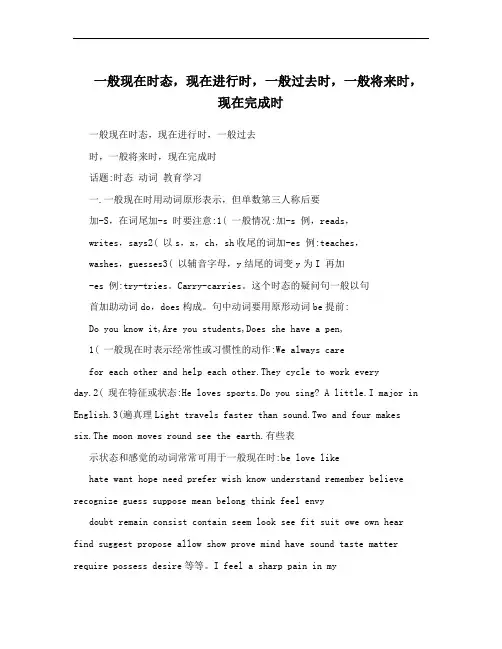
一般现在时态,现在进行时,一般过去时,一般将来时,现在完成时一般现在时态,现在进行时,一般过去时,一般将来时,现在完成时话题:时态动词教育学习一.一般现在时用动词原形表示,但单数第三人称后要加-S,在词尾加-s 时要注意:1( 一般情况:加-s 例,reads,writes,says2( 以s,x,ch,sh收尾的词加-es 例:teaches,washes,guesses3( 以辅音字母,y结尾的词变y为I 再加-es 例:try-tries。
Carry-carries。
这个时态的疑问句一般以句首加助动词do,does构成。
句中动词要用原形动词be提前:Do you know it,Are you students,Does she have a pen,1( 一般现在时表示经常性或习惯性的动作:We always carefor each other and help each other.They cycle to work everyday.2( 现在特征或状态:He loves sports.Do you sing? A little.I major in English.3(遍真理Light travels faster than sound.Two and four makes six.The moon moves round see the earth.有些表示状态和感觉的动词常常可用于一般现在时:be love likehate want hope need prefer wish know understand remember believe recognize guess suppose mean belong think feel envydoubt remain consist contain seem look see fit suit owe own hear find suggest propose allow show prove mind have sound taste matter require possess desire等等。

七年级英语语法----时态(一般现在时现在进行时一般过去时)学习手册在七年级英语学习中我们主要学习了3种时态,即一般现在时现在进行时一般过去时。
今天我们就将这3种时态进行对比学习。
Come on my friends!一、一般现在时定义:表示经常、反复发生的动作,经常存在的状态或者习惯性动作(有时间规律发生的事情)的一种时间状态。
(很拗口,但要学会就必须深刻体会,so please 将其狂读3遍)具体用法1、表示经常的或习惯性的动作,常与表示频率的时间状语连用。
(always, usually, often,sometimes, every day\ morning\ night\ evening\afternoon\week,)e.g. I go to school at 8:00 every morning.2 表示主语具备的性格、能力、特征和状态及喜好等。
e.g She is 11 years old .I don’t like English.She can speak English well.3表示客观事实和普遍真理。
e.g The earth moves around the sun.基本结构构成含有be(am、is 、are)动词的用法肯定句:I am+其它You \ they\ we are +其它She \he \ it+is +其它否定句:I am not+ 其它。
You \ they\ we are not +其它She \he \ it+is +not +其它一般疑问句及回答:Are you +其它?肯定回答:yes, I am. 否定回答:no, I am not.Are you\ they\ you+ 其它?肯定回答: yes,we \they are. 否定回答:no, we \they are not.Is she\ he \it+其它?肯定回答: yes,she \he \it is. 否定回答:no,she \he \it is not.从上面结构中你能总结出be动词的用法吗?单数________,复数_________ ;我用_________,你用__________ ,______________-连着她他它。
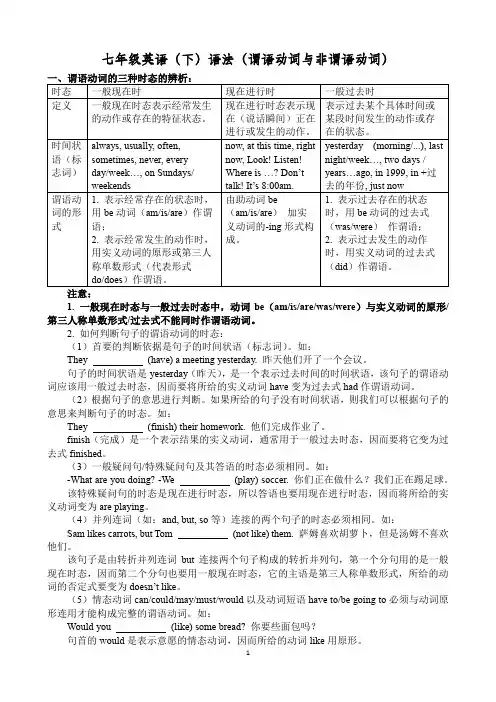
七年级英语(下)语法(谓语动词与非谓语动词)1. 一般现在时态与一般过去时态中,动词be(am/is/are/was/were)与实义动词的原形/第三人称单数形式/过去式不能同时作谓语动词。
2. 如何判断句子的谓语动词的时态:(1)首要的判断依据是句子的时间状语(标志词)。
如:They (have) a meeting yesterday. 昨天他们开了一个会议。
句子的时间状语是yesterday(昨天),是一个表示过去时间的时间状语,该句子的谓语动词应该用一般过去时态,因而要将所给的实义动词have变为过去式had作谓语动词。
(2)根据句子的意思进行判断。
如果所给的句子没有时间状语,则我们可以根据句子的意思来判断句子的时态。
如:They (finish) their homework. 他们完成作业了。
finish(完成)是一个表示结果的实义动词,通常用于一般过去时态,因而要将它变为过去式finished。
(3)一般疑问句/特殊疑问句及其答语的时态必须相同。
如:-What are you doing? -We (play) soccer. 你们正在做什么?我们正在踢足球。
该特殊疑问句的时态是现在进行时态,所以答语也要用现在进行时态,因而将所给的实义动词变为are playing。
(4)并列连词(如:and, but, so等)连接的两个句子的时态必须相同。
如:Sam likes carrots, but Tom (not like) them. 萨姆喜欢胡萝卜,但是汤姆不喜欢他们。
该句子是由转折并列连词but连接两个句子构成的转折并列句,第一个分句用的是一般现在时态,因而第二个分句也要用一般现在时态,它的主语是第三人称单数形式,所给的动词的否定式要变为doesn’t like。
(5)情态动词can/could/may/must/would以及动词短语have to/be going to必须与动词原形连用才能构成完整的谓语动词。
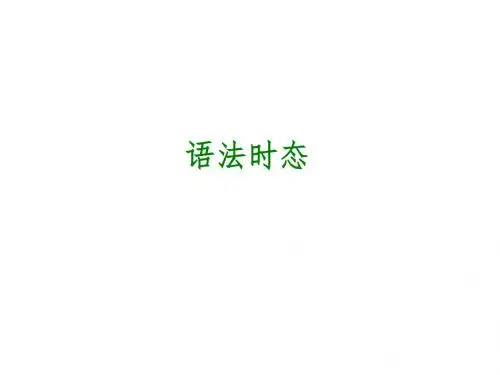
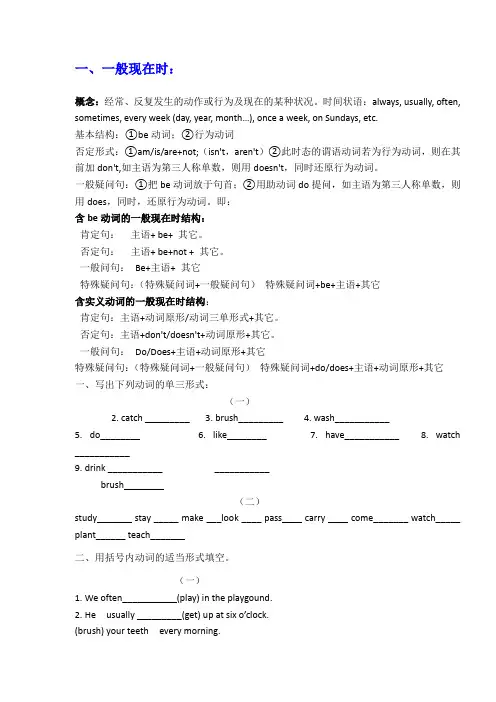
一、一般现在时:概念:经常、反复发生的动作或行为及现在的某种状况。
时间状语:always, usually, often, sometimes, every week (day, year, month…), once a week, on Sundays, etc.基本结构:①be动词;②行为动词否定形式:①am/is/are+not;(isn't,aren't)②此时态的谓语动词若为行为动词,则在其前加don't,如主语为第三人称单数,则用doesn't,同时还原行为动词。
一般疑问句:①把be动词放于句首;②用助动词do提问,如主语为第三人称单数,则用does,同时,还原行为动词。
即:含be动词的一般现在时结构:肯定句:主语+ be+ 其它。
否定句:主语+ be+not + 其它。
一般问句:Be+主语+ 其它特殊疑问句:(特殊疑问词+一般疑问句)特殊疑问词+be+主语+其它含实义动词的一般现在时结构:肯定句:主语+动词原形/动词三单形式+其它。
否定句:主语+don't/doesn't+动词原形+其它。
一般问句:Do/Does+主语+动词原形+其它特殊疑问句:(特殊疑问词+一般疑问句)特殊疑问词+do/does+主语+动词原形+其它一、写出下列动词的单三形式:(一)2. catch _________3. brush_________4. wash___________5. do________6. like________7. have___________8. watch ___________9. drink ___________ ___________brush________(二)study_______ stay _____ make ___look ____ pass____ carry ____ come_______ watch_____ plant______ teach_______二、用括号内动词的适当形式填空。
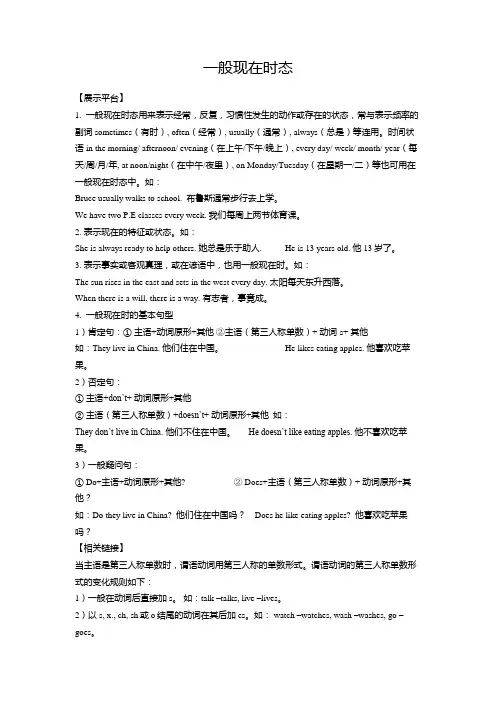
一般现在时态【展示平台】1. 一般现在时态用来表示经常,反复,习惯性发生的动作或存在的状态,常与表示频率的副词sometimes(有时), often(经常), usually(通常), always(总是)等连用。
时间状语in the morning/ afternoon/ evening(在上午/下午/晚上), every day/ week/ month/ year(每天/周/月/年, at noon/night(在中午/夜里), on Monday/Tuesday(在星期一/二)等也可用在一般现在时态中。
如:Bruce usually walks to school. 布鲁斯通常步行去上学。
We have two P.E classes every week. 我们每周上两节体育课。
2. 表示现在的特征或状态。
如:She is always ready to help others. 她总是乐于助人. He is 13 years old. 他13岁了。
3. 表示事实或客观真理,或在谚语中,也用一般现在时。
如:The sun rises in the east and sets in the west every day. 太阳每天东升西落。
When there is a will, there is a way. 有志者,事竟成。
4. 一般现在时的基本句型1)肯定句:①主语+动词原形+其他②主语(第三人称单数)+ 动词-s+ 其他如:They live in China. 他们住在中国。
He likes eating apples. 他喜欢吃苹果。
2)否定句:①主语+don’t+ 动词原形+其他②主语(第三人称单数)+doesn’t+ 动词原形+其他如:They don’t live in China. 他们不住在中国。
He doesn’t like eating apples. 他不喜欢吃苹果。
七年级英语时态汇总一般现在时【定义】一般现在时表示现在经常反复发生的动作、存在的状态或习惯性的动作。
即描述我们日常生活中的衣食住行等活动。
【用法】(1) 在实际应用中,一般现在时常与以下时间状语联用:always, usually, often, sometimes, every week (day, year, month, once a week, on Sundays ……例句:He usually plays football on Sundays.(2)没有时间状语,可以分以下四种类型:这一类型由be动词+名词、形容词、副词、代词、数词或介词短语等一起构成谓语,表示主语的个性、特征或状态。
如:①I am a student.(主语+be动词+名词)②They are hungry.(主语+be动词+形容词)③He is out.(主语+be动词+副词)④That pen is mine.(主语+be动词+代词)⑤I am fifteen.(主语+be动词+数词)⑥The bike is under the tree.(主语+be动词+介词短语)do型由行为动词充当谓语,表示经常性或习惯性的动作,其构成为。
如:①I know it. ②He believes me.there be型句子表示“某地存在…”,其构成为,表示客观事实。
用法遵循,即主语是单数或并列主语中的第一个主语是单数,则用there is;主语是复数或并列主语中的第一个主语是复数,则用there are。
如:(1)There is an eraser on the teacher's desk.(主语an eraser是单数)(2)There is an orange,five apples and eight bananas in the bag.(并列主语中的第一个主语an orange是单数)情态动词型句子的构成为,情态动词和动词原形一起构成谓语,表示说话人对所叙述的动作或状态的看法。
七年级英语下册时态和知识点专题复习(1)一.一般现在时:(1、现在的状态。
2、经常或习惯性动作。
3、主语所具备的性格和能力。
4、真理。
)1、标志:often(经常),usually(通常),sometimes(有时),always(总是),never (从不),on Sundays(在星期天), every day/month/year(每一天/月/年)2、结构:(1)主语+连系动词be(am/is/are)+名词/形容词/数词/介词短语/副词等做表语表状态(包括There be +n.)练习:1.I__am____(be) a student. My name__is___(be) Tom.2. Where __are___(be) my shoes? They_are__(be) here.3.Who _is___(be) the girl with long straight hair? I think she _is__(be) Kate.4. You and I _don’t are__(not be) in Class Six.5._Are__(be) there a supermarket on the Fifth Avenue?Yes, there_are____(be).6. _Do___ her parents tall? No, she__don’t__.(2)主语(非第三人称单数)+行为动词原形+其他(用助动词do 帮助构成否定句、一般疑问句和特殊疑问)(3)主语(第三人称单数)+行为动词的第三人称单数+其他(用助动词does 帮助构成否定句、一般疑问句和特殊疑问句)行为动词第三人称单数加-s的形式:1.- s2. 辅音+y: study-studies3.以s,x,ch,sh结尾watch-watches teach-teaches4特殊have-has do-does go-goes肯定句1.His parents _______(watch) TV every night.2. My brother _________(do) homework every day.否定句1)His parents _________(not watch) every night.2)My brother________(not do)homework every day.一般疑问句1_____his parents_____(watch) TV every night?Yes, they _______. No, they _______.2______ your brother _____ homework every day?Yes, he______. No, he _________.特殊疑问句1When___ his parents _____(watch) TV? They watch TV every night. 2When _____ your brother ____(do) homework?He does homework every day.( )1.The waiter in a restaurant usually wears__________uniform. A.an B.a C.the D./( )2.I don’t like Sichuan food. I think it’s really__________.A.deliciousB.niceC.cheapD.hot( )3.Mrs Jameson went to the park with a __________boy.A.five-years-oldB.five-year-oldC.five year oldD.five years old ( )4. It often________in South China. There is much________.A.rain; rainB.rains; rainsC.rains; rainD.rain; rains( )5.My mother often asks me__________late for class.A.not beB.not to beC.am notD.not七年级英语下册时态和知识点专题复习(2)二.现在进行时:表示说话瞬间或现阶段正在进行的动作。